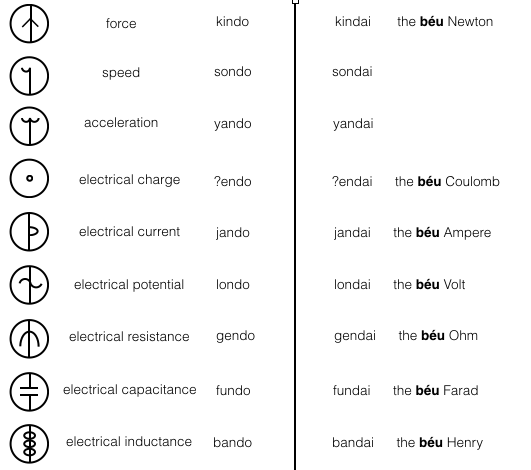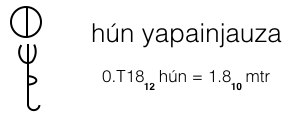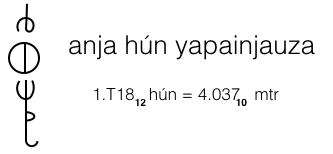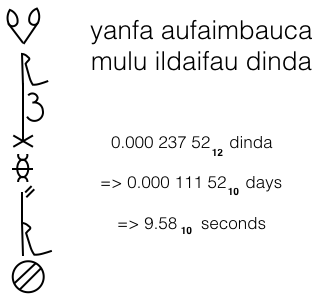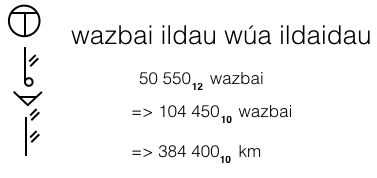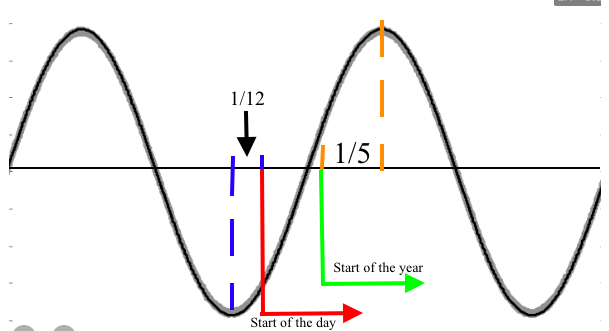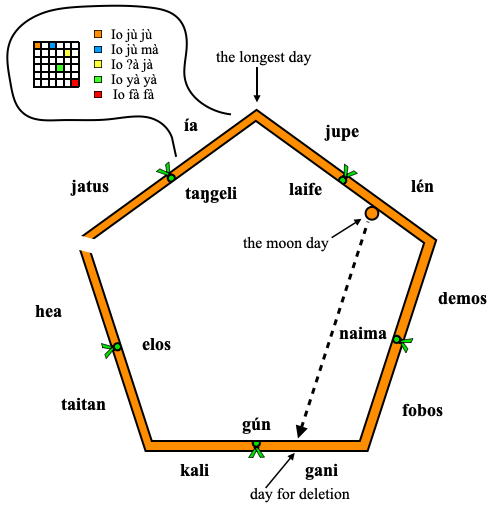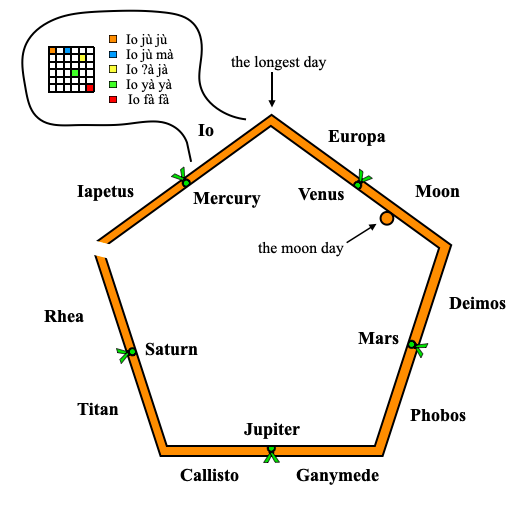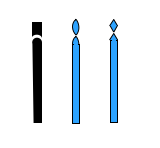Béu : Chapter 8 : Way of life 2
..... Identification
..
Followers of béu sometimes display subtle allusions to their allegiance. For example a piece of jewelry or a small tatoo featuring three shapes ... never identical ... but repeating the same theme. For example this earing ...
would suggest that the wearer might be a follower.
..
Also beumai reveal themselves through behaviour ...
1) When giving or receiving any object ... no matter how small ... always two hands are used. This is considered polite.
2) Bodily contact is not considered polite with people not of the immediate family (at least in formal occasions) so no handshakes ... definitely no hugging. A gesture like the Thai "wai" is used for greetings.
3) Never any eating or drinking when walking ... when standing is acceptable. Also talking with a full mouth is considered rude.
4) Farting, betching and making a noise while eating is considered rude.
..
If two beumai meet they might start inserting well known béu phrases into the conservation. If both are comfortable with this the percentage of the conversation undertaken in béu increases. A good knowledge of the language is respected.
..
..... Squares of Honour
..
Also called Noble Squares.
An individual can be awarded a noble square for service to society. They are not awarded for continuous good service but for one piece of service. For example … writing a book (fiction or non-fiction) which is greatly admired, coming up with a new scientific theory or in war … planning a clever campaign.
They are not awarded for skill in games or breaking a running record for example. See these two examples …
..
..
The recipient of the award should display it on his ??? . Also the children of the awardee have the right to display the reward. And the children of these children have the right to display the reward. So it passes on down the generations until the 432nd* person has displayed it. Nobody after this 432nd person can display the square. When they die the square is retired (or faded as they say)
There are 215 different regulations concerning the design of the noble squares. For example the first regulation concerns the % of plain color you are allowed to have without any embellishment … actually this single regulation runs to 2015 words. Anyway … all these stipulations give all the noble squares the same sort of “flavor”.
*432 10 = 30012
..
..... Road Signs
Distance signs are placed on the right hand side of the road (cars drive on the RHS of the road by the way). The leftmost place name has a red backgound and this signifies the place that will be arrived at by not changing roads. The other destinations signify places that you will reach by changing road and these places have a non-red coloured background.
The numbers represent wazbai ( 1 wazbai => 3.68 km)
..
Above is a more usual distance sign. Usually only one destination is mentioned on a distance sign.
..
The above is what to see as you come up to a orthogonal four-way intersection.
..
The above is the sign that you will see as you approach a five-way intersection. Note that in this case there is no road leading off to the left at 90 degrees. This is shown on the sign by a vertical black stripe on the leftmost extremity of the top area.
Also note that the angle that a road makes is mirrored by the position of the coloured disc at the top of the sign.
..
When the central red disc is missing you know that you are about to join a larger road. The road name will change.
..
However if a road joining an intersection makes an angle of less than 90 degrees with the road you are on, then this angle is not represented on the top of the sign. Instead this road is represented by a hemi-disc at the extremity of the top area on the sign.
..
And in the unlikely case when you have two of these roads joining from the same side, they are represented ny quarter-discs.
..
The above is what you pass through when you enter a town. There can be no "Welcome to Pleasantsville" written. It should just be a plane red colour on top. The name of the town on the sides.
On the opposite side of this sign, the red colour will be green. There will be nothing at all written anywhere on the other side ... next town ???
..
..... Street Signs
..
Below is a plan view of a typical intersection about halfway along a street. The street is measured from one end. The unit of measurement is 2.13 mtrs In this example the down block starts at 559 units and ends at 630 units, and the up block starts at 637 units and ends at 6EI units. (Remember that we are using base 12 and E stands for eleven).
..
[Drawn twice above, just to give clarity to my indication arrow lines]
These street signs are placed in from the corner, a distance equal to 60 % the width of the street (measured building wall to building wall). They are well above head hight and offset from the wall by 60 % of the sign width. The information giver on the sign is ... the distance (from the beginning of the street) of the near side and the far side of the block you are looking at plus the name of the street. The streets that cross "Hanging Apple Street" are not indicated anywhere on "Hanging Apple Street" ... this would be a problem if there was vehicular traffic on the street ... but these streets do not have vehicular traffic.
..
(a) and (b) are exactly the same, as is (c) and (d) ... it is just the mean of securing the sign to the wall that changes.
Notice that (a) and (c) are opposite sides of the same metal frame hence they mut be the same physical length. However the space that the numbers take up will vary. To make things match out, in the side with the more compressed numbers, the black space is expanded in 4 places.
No street can be longer than 1,872 units long (about 4 km)
Buildings on the street don't have numbers as such. Or rather the number they are given is equivalent to how far their letterbox is from the beginning of the street (measured in units of 2.13 mtrs of course). If two letterboxes on opposite sides of the street were the same distance along, one of then would be incremented by one unit.
OK ... so far so good. But things get a bit more complicated at street ends (and beginnings). Below is a plan view of the intersection where "Hanging Apple Street"(blue) ends and "Ploughing Horses Street"(green) starts.
..
..
[Above, I haven't pointed out every sign, just enough to give you an idea what is happening]
Zero units is indicated on the sign as a black dot. All signs adjacent to the end or beginning of a street have their distance numbers hi-lited in red. Also if you have a sign indicating strret B and the sign is physically on street A ... then "B" is hi-lited blue.
..
The numbers of a street increase as you approach the centre of the city. Also they increase as a street goes anti-clockwise around the centre of the city.
Strip lights are also attached to the side of the buildings. This light is focused onto the signs when it gets dark.
..
..... Buildings Signs
..
Quite similar to the node sign for roads is the sign giving directions in major buildings (such as airports, train stations etc.). However the position of the coloured circles does not show the angle that the joining road takes at the intersection. It shows the angle from the reader to the destination beacon. Actually there is a big black ring on the floor and it is assumed that the reader is within this ring. It is the angle from this ring to the destination beacon that is represented by the position of the coloured circles.
..
..
At the bottom of the diagram above, can be seen the destination beacon. It is a sphere about 50 cm in diameter. It is supported by a black pillar which is about 6 foot high. The beacon colour follows the colour of the circle in the sign. The beacon should be located in a clear (unobstructed) area maybe about 20 or 30 mtrs from the destination (for example toilets, information desk, screens displaying timetables, passport control etc. etc.). For course the destination should be clearly visible from near the beacon.
..
..
The signs at the middle of the above diagram are found near stairways and escalators. Upon stepping off a stairway the sign on the LHS should be clearly visible. This shows what floor you are on (ground floor is floor one by the way). The other two signs are positioned near the entrance to a stairway and tell you where the stairway is going.
..
..... The House Cell
In the Christian religion, for the average adherent, the hour spent in church on Sunday represents the main obligation ... in terms of time anyway. Of course most Christians support their church financially and often their devotion results in some socialising with their fellows believers. This socializing usually has the aim of doing good-works but of course people enjoy socializing and these get-togethers often supply moral support with respect to personal problems and probably there is mutual re-enforcing of beliefs and a feeling of "solidarity" with respect to life's problems and the rest of the world in general.
The main time demand for a beuki is not sitting in a church listening to sermons but privately reading. This reading is done in a special room called a "cell". The volumes containing the body of knowledge that is considered "canonical" is read.
This reading is the most basic obligation however and most also go in for other "duties" such as dietary restrictions and prescribed daily excercise routines (to some extent at least). Many also volunteer time and money to the many activities which are proscribed by béu to promote personal happiness and social cohesion (these activities are actually designed to have the results (mentioned in the above paragraph) which seems like a chance by-product of certain Christian practices).
Other sections will go into detail about the duties touched on above. However this section is only about how the requirement to spend a certain time each day, reading the body of knowledge that béu considers "canonical" * affects the architecture of the typical béu followers place of residence.
..
..
The above shows the plan view of a "cell" : the room in which the reading of the "canonical" works is done. There is usually a cell in every family dwelling. It is a requirement that the cell is perfectly square and is windowless. Also the only lighting permitted is two oil lanterns fitted over either shoulder of the "reader" to cast light over the top of the lectern.
Behind the door is situated the bookcase that contain the "tomes" that constitute the béu canon. It is attached to the wall as opposed to standing on the floor. It can also be recessed into the wall.
Facing the door there is a large tapestry (a poster would also do). The image is usually of an awe-inspiring view of nature. However colourful fractals or geometric patterns are also quite common.
The rectangular object is a lectern. And behind the lectern is a comfy seat. And either side of the seat (above on the wall) are two lanterns.
As can been seen, the seat and the lectern are quite low. The chair is legless and the usual method is just to cross your legs on the floor just to the front of the seat.
It is common to excercise and bathe before doing your daily reading. Also many change into loose robes of a light blue colour, before entering the cell.
On the wall facing the lectern is "the shelf".
..
..
Below is shown a robe that is optionally put on before entering the cell to read. It is light blue ... quite similar to a robe that an Egyptian peasant would wear.
..
..
Below is shown the shelf attached to the wall facing the reader. About 4 or 5 feet of the ground. It is in the shape of an ellipse from which a third has been cut off from the depth, allowing it to be flush with the wall. In the middle is a small naked flame in a glass. Either side of the are two oblong vases with flowers. On the extremities (over the focuses) are two objects d'art. (the support or supports for the shelf are not shown)
..
..
Below is shown one of the lanterns. Obviously to prevent fire these ate placed in fairly substantial brackets connected to the wall.
..
..
Other items sometimes found in the cell ...
The books are meant to be read in 20 minute sittings and there is ofter an egg-times that counts out about 20 minutes. Usually about 6 inches high and kept on a special indentation on the lectern
A large glass goblet filled with marbles. They are numbered and come in different sizes. Used for keeping a record of what chapters have been read. All the marbles from one book would have the same size and colour. Perhaps inside the lectern is a large wooden tray with indentations. One indentation for every marble. When the goblet is empty and the tray is full, the course of study has been completed.
Large cards. A bit like playing cards but bigger and more solid. Each with intricate designs on it. Usually some sort of fancy box for them as well. These are for keeping a record of what chapters have been read.
Obviously if you have the cards you won't need the goblet and vice versa.
..
- At the present time, the body of work that is considered "canonical", consists of 15 volume (at the present time)s. However unlike other movements ... in béu, there is actually a mechanism for updating and improving these "proscribed books". The very opposite to every other religion. Every other religion has shown a strong instinct to hastily gather a body of script together and then to "set it in stone" ... well that is a by-product of our mental make-up. Hopefully the results of a more deliberate method will also be considered worthy of reverence ( or a little consideration at least :-) ).
..
..... The Revered Volumes
Well there is the main volume of course ???
..
Then there is the 5 volumes containing the "5 main subjects".
History ... I have temporarily made Jared Diamonds book, "Guns, Germs and Steel" canonical (until the proper tome can be written of course).
Mathematics ...
Chemistry ... (maybe 30 % of the pages of this book will be given over to organic chemistry)
Physics ... Actually more comprising what I would call Engineering Science ( motion of bodies, forces and their direction within a bridge, etc. etc. )
The language of Béu ... actually a broader linguistic course
..
Then there is the 5 volumes containing the "5 minor subjects".
Human Physiology/Health ... maybe about 10 % of the pages of this book will be given over to how other animals do things (after first explaining how the human body does things of course)
The Civil Society which surrounds the beuki ... for example banking system, mortgages, local government, central government, tax, how the tax money is spent etc.etc.
Geology ...
Geography ... physical shape and how countries interconnect ... populations and population growth ... stage of development ( country by country or region by region )
Accounting/economics ...
..
We soon get on to "practical" subjects, such as metalwork, which is not really suited to be learnt solely from a book. So no more subjects needed ... better to restrict them to 10.
..
Then there is the x volumes concerning behaviour. (That is interpersonal relations)
General behaviour ... I have temporarily made Dale Carnegie's book, "How to win friends and influence people" canonical (until the proper tome can be written of course).
Husband <--> Wife ... I have temporarily made Nancy Van Pelt's book, "Highly Effective Marriage" canonical (until the proper tome can be written of course).
Employee <--> Employer ... There was a very good book by two guys with Dutch sounding names ... published at least 20 years ago ... I can not remember or find the book at the moment.
Child <--> Parent ... ???
..
Then there is a smallish book about First Aid
..
..
These canonical book are not set in stone however. There will be a mechanism for updating them.
Maybe this seems like a contradiction of terms ... a canonical body of work, yet mere mortals are allowed to change it. Well for some reason it is accepted by the beuki. Of course the scholars who update the work are very respected and there is a lot of conferring done before any update (also "any" bickering about what to update, is kept well out of the public eye).
..... The Reciprocal Hosting Scheme
Many of the delights of life are found in the company of fellow human beings. Especially like-minded human beings. A lot of the customs of béu are designed especially to help people find that delight, to make them feel as if they are part of something bigger than any individual, to feel as if they are part of a community. The following is a tradition that has been designed with this in mind.
Every 3 seasons everybody is expected to get together with one other person and invite 2 strangers to dine (usually it will be to a home of one of the inviters). This is arranged by the local town hall. It is to facilitate meeting people that live near to you but that you do not know well. It is meant to be an enjoyable occasion for all involved. Only the 4 people should be present. Sometimes the hosts are siblings, sometimes a couple and sometimes friends. Usually the invitees do not know each other very well ... but sometimes they are a couple. Obviously some people are not into this sort of thing so they shouldn't be forced ... but they should be encouraged to be both hosts and guests.
..... The Banners of the Parish
..
The country side is divided into "parishes". A parish is a rural communities of 10,000 to 50,000 people (urban areas are very different from rural areas and have a different administrative structure). The shape of a parish approximates to a hexagon. But where possible the parish boundaries follow geographical features, such as streams and ridges etc. In a total featureless landscape the shape of a parish would be a hexagon.
A normal parish would have 6 banner-rows along its boundaries. A banner-row consists of 17 banners about 10 m apart. Each banner is made from a pole about 5 inches in diameter. Each pole is about 7.5 m high and the top 5 m of the pole has an black banner. The cloth of the banner is about 1/3 m wide. When about half the original cloth has been weathered away the cloth should be replaced. Usually an entire is replaced at on time. These banner-rows are normally placed in prominent positions. They can be anywhere along a boundary, but it isn't considered good to have the gap too small or too big between any neighbouring banner-rows.
About 2/3 of the way out from the parish centre there are what are called the outer banners. There are 5 of these banner-rows and each has 11 banners. Again these are in prominent positions and/or well visible from roads. Again each banner-row should be quite spread out with respect to the others. These banners have cloth of light blue. They are arranged to point towards the tunheu. The banner nearest the tunheu is about a meter shorter than the others.
About 1/3 of the way out from the parish centre there are what are called the inner banners. There are 4 of these banner-rows and each has 5 banners. Again these are in prominent positions and/or well visible from roads. Again each banner-row should be quite spread out with respect to the others. These banners have cloth of orange. They are arranged to point towards the tunheu. The banner nearest the tunheu is about a meter shorter than the others.
..
Below is what one banner would look like.
..
And below is a plan of a typical parish. I just made it a perfect hexagon ... what you would get in perfectly flat land unbroken by any rivers.
| type of banner row ... | numbers of banners per row ... | colour of banners ... | numbers of rows |
| rim | 17 | black | 6 |
| outer | 11 | light blue | 5 |
| inner | 5 | orange | 4 |
..
In sparsely populated areas you get what is called a super-parish. They are around 10 times the size of a normal parish (but their population falls within the 10,000 to 50,000 limit). These super-parishes have 2 barrier-rows per side(that is 12 in total), and each banner-row has 19 banners. All these banner dimensions are about 15% to 20% bigger than normal. Super-parishes are more likely to have a very irregular shape. Below is the parameters and an example of what a super-parish would look like.
..
| type of banner row ... | numbers of banners per row ... | colour of banners ... | numbers of rows |
| rim | 19 | black | 12 |
| outer | 13 | light blue | 8 |
| inner | 7 | orange | 5 |
..
... Units of Measurement
..
The béu units of measurement (ajan) all have their own symbol. As with numbers, they are never written out phonetically but the symbol is always used.
Below are the first 12 ajan.
..
..
The unit of distance is the wazbai (3.68 km) .... [ = 1/100012 the radius of the earth ]
..
The unit of height is the hún (2.13 m) ............... [ = 1/100012 x wazbai ]
..
The unit of weight is the pundai (5.6 kg) .......... [ = 1/100012 the weight of water in a cube of sides one hún long ]
..
The unit of time is the dindai (1 day)
..
The unit of temperature is the mandai (87 degrees Kelvin)
This makes the temperature of the human body equal to 3 1/2 units. 3.0 manda is minus 12 degrees celsius and 4.0 manda is plus 75 degrees celsius. As the temperature of the air is nearly always between these two limits, when people discuss the weather, they invariably drop the initial "3".
..
The unit of area is the nondai (1.94 acres) ... [ = 100012 the area of a square of sides one hún long ]
..
The unit of angle is the tendai (90 degrees)
..
The unit of pressure is the cundai (3162 N/m2 = 0.485 psi) ... [ = 1,000,00012 x kindai/nondai ]
..
The unit of volume is the hundai (3.24 cm3) ... [ = 1/1,000,00012 x the volume of a cube of sides one hún long ]
..
The unit of fluid flow is the sloidai* ( 0.4 m3/hour) ... [ = the volume of a cube of sides one hún long / dindai ]
..
The unit of energy is the kuandai** ( 17.72 Joules = 2.3 kWh) ... [ hún x kindai ]
..
The unit of power is the wildai*** ( 205 μWatt ) ... [ kuandai / dindai ]
..
* slòi is a verb meaning to flow.
** kuan is a noun meaning energy.
*** wila is a noun meaning power.
..
And below is a further 9 ajan ...
..
..
The unit of force is the kindai (8.32 Newtons) ... [ = pundai x yandai ]
..
The unit of speed is the sondai (4.3 cm/sec) ... [ = wazbai/dindai ]
..
The unit of acceleration is the yandai (1.486 m/sec/sec) ... [ = 1,000,00012 x wazbai/dinda/dinda ]
..
I haven't as yet worked out appropriate values for the electrical units. On thing to note is that sometimes the symbol for electrical potential (voltage) sometimes has a variant (see below).
..
..
This is used where you have direct current.
..
Now we must lay down how the unit word interacts with the number and with the 7 number "placeholders". This must be defined for both speech and notation.
Well first of, if the number is such that it is next to sanja (the decimal point), then sanja is replaced with the units being used (in both recitation and in notation). For example hún is the unit used to measure height (it equals 2.237 mtr). My height (1.8 mtrs) would be pronounced hún yapainjauza.
A height of 4.037 mtrs would be pronounced as anja hún apaijauza.
Now if the number doesn't occur next to sanja but on one side of a placeholder, then the unit is placed on the opposite side from the placeholder.
Which is ... by the way ... the current (Oct 2012) record time for the 100 mtr sprint.
..
If the number occurs on both sides of a placeholder, then the unit is place at the very front.
Which is ... by the way ... is the distance from the earth to the moon..
Notice that in the notation the numbers must be contiguous with the placeholders. If there is a gap, then the sign for "h" must be inserted into the gap. Exactly as we insert zero's. But one different between our system and the béu system, is, in our system, zero's must be inserted to make the number contiguous with the decimal point (assuming we are using non-scientific notation), in the béu system "h"'s must be inserted to make the number contiguous with any placeholders that are used.
The béu system may at first appear more complicated then the systems currently used. However it is all a matter of familiarity. It is just due to exposure to it for most of our lives that, for example, using hours, minutes and seconds seems so easy. With all equal amount of exposure, the béu system would be even easier.
In our SI system, magnitude words are prefixed to the unit of measurement (for example "kilo" in kilometre). béu also has magnitude words (the placeholders) but they are inserted into the number itself (the béu system is better than the SI system because you get a different magnitude word every time your dynamic range passes 1728). Notationwise, it is a bit similar to the way we use comma's to separate a long number string into groups of three digits.
..
... Regions of the world
..
| ploni | North America | <= | plona | North Americal Bison | |
| caltini | South America | <= | caltin | Lama | |
| blauni | Europe | <= | blauna | Irish Elk | |
| jaini | Africa | <= | jain | Lion | |
| paibi | Asia | <= | paibian | Panda | |
| wombani | Australia | <= | wombana | Kangaroo | |
| moani | Oceana | <= | mo.a | Moa | |
| piŋgoli | Antarctica | <= | piŋgolo | penguin | |
| kwuhani | The arctic | <= | kwuha | polar bear | |
| hindi | India | ||||
| fiadani | The Middle East |
..
The world is divided into 1110 regions. Nine of them have an association with an animal. [7] includes New Guineau as well, actually anything under the Wallace Line. [7] includes New Zealand.
The border between paibi and blauni is not the Ural Montains. It follows roughly a line from the khyber pass, up the east side of Kazakstan, passing close to Krasnoyarsk and up to Anabar bay on the Arctic Sea.
The extant of kwuhani is shown below. It entails all the green area PLUS the white area inside this green area.
Note : fía = "between" or "among" : fiada = "middle" or "centre"
..
... The time of day
..
beugan is interesting as to the phases of the day and of the year. The day starts at 02:00 and the year starts just after the spring equinox.
..
Above, the zenith of the sinusoid represents both high noon and mid-summer ... the nadir, midnight and the shortest day.
The fractions in the above diagram refer to offset as a fraction of one cycle.
..
The 24 hour period has six major divisions.
..
| 02:00 => 06:00 | pre-dawn .... | jù aús |
| 06:00 => 10:00 | morning | a?aus |
| 10:00 => 14:00 | mid-day | imaus |
| 14:00 => 18:00 | afternoon | uyaus |
| 18:00 => 22:00 | evening | ejaus |
| 22:00 => 02:00 | midnight | ofaus |
..
The second column is the nearest equivalents I could think of. jù aús of course means "zero period".
As for the others, well a bit of a dispute there, some think a?aus is a contraction of a?au aús, some think it is a?au with the adverbial marker -s. No matter.
OK ... we have divided the day into 4 hour segments. We can further divide each of these major time periods into six 40 minute intervals. By way of example, lets sub-divide the evening.
..
| 18:00 => 18:40 | ejaus jù aús .... | evening, zero period |
| 18:40 => 19:20 | ejaus a?ai.a | evening, the tens |
| 19:20 => 20:00 | ejaus imai.a | evening, the twenties |
| 20:00 => 20:40 | ejaus uyai.a | evening, the thirties |
| 20:40 => 21:20 | ejaus ejai.a | evening, the forties |
| 21:20 => 22:00 | ejaus ofai.a | evening, the fifties |
..
Note : 02:00 => 02:40 is called jù aús jù aús. I guess if it was used a lot it would get eroded to jù jù aús but I don't see this period of time being talk about a lot..
..
Now aús relates to a period of time. jé (meaning "at" but w.r.t. time) relates to an instant of time. It is logical to think that if we keep dividing up a period of time we would approach to an instant in time. A further division by 6 gives us 6 minutes + 40 seconds. In béu culture this is considered an instant ... like if you arranged to meet somebody, the meeting would only be specified to the nearest 6 minutes + 40 seconds (I guess it is quite a relaxed culture).
By way of example, lets sub-divide "evening, the forties".
..
| 20:40:00 => 20:46:40 .... | jé jà jà jù | |
| 20:46:40 => 20:53:20 | jé jà jà ?à | |
| 20:53:20 => 21:00:00 | jé jà jà mà | |
| 21:00:00 => 21:06:40 | jé jà jà yà | |
| 21:06:40 => 21:13:20 | jé jà jà jà | |
| 21:13:20 => 21:20:00 | jé jà jà fà |
..
When these special short number forms are used, you always have three of them and they always follow jé
..
Every instant that end if jù has an alternative form. For example jé jà jà jù can also be expressed as ejaus jé ejai
And that's about it for the time of day.
..
... The naming cycle
..
We have 374 male names and 374 female names. You are bestowed a name depending upon the day you are born on.
After this cycle it repeats, so two guy born 374 days apart will have the same name. Likewise with girls.
One of these cycles is called fakas (fá = "name" : kas = "cycle"/"revolution"). Each fakas has an animal emblem associated with it. There are 125 emblems or toze as they are called. I have listed the 125 toze below ...
..
| ?eble | iguana | ?usfa | giraffe | ?inte | ant | ?intebian | anteater | melba | gecko | |
| mazna | lemur | mias?a | Steller's sea cow | moa | moa | myata | duck | myolan | swan | |
| mbu?o | badger | mboza | hyena | mpaipe | spider | mpau | dove | yeme | frog | |
| yuatua | walrus | yizgi | black skimmer | yoihu | swordfish | jàin | lion | jambe | pelican | |
| jolomo | mole | jo?ila | cheetah | jwufu | triceratops | jwí | rabbit | felu | jackal/fox | |
| juages | opossum | fanfa | horse | fi.ambo | frill-neck lizard | fyake | springbok | wombana | kangaroo | |
| fleu?en | falcon | flimi | snail | bazlin | wolverine | badwa | bullfinch | biabia | butterfly | |
| baumal?o | gnu/wildebeest | byema | cape buffalo | byoas | cobra | bletus | auroch | blauna | Irish Elk | |
| bwebwe | humming bird | bwo?uma | colossal squid | gaifai | flamengo | guputa | parrot | gialti | glyptodon/doedicurus | |
| goizon | chameleon | glufan | driprotodon(wombat) | gloyun | hornbill | gwúa | python | gwía | gemsbok | |
| demotis | gorilla | dalpan | capybara | dospondo | aardvark | daugomo | porcupine | dwolhe | crocodile/alligator | |
| dwòi | lobster | lea | red panda | launga | jaguar/panther/leopard | lidilika | dragonfly | loitoma | ostrich | |
| celigo | hedgehog | caltin | lama | calai | tiger | cau?en | bat | cwemen | whale | |
| cwitopa | octopus | seloki | lynx | sadu | elephant | salubi | megatherium | ʃinti | squirrel | |
| slaikan | cormorant/shag | slianiŋki | chimpanzee | sweton | wartho | swoljo | musk oxe | kaimyai | vulture | |
| kendo | goat | kuakua | seahorse | kiampi | seal | kiwon | rhino | kaukwa | grouse | |
| kyohazlo | praying mantis | klekle | cicada/cricket/grasshopper/locust | klozo | hawk | kwuha | polar bear | kwono | raccoon | |
| paibian | panda | palbuma | T-rex | pikau | peacock | pingolo | penguin | pyès | manta ray | |
| pyiaʒi | meerkat/mongoose | plantos | weasel/ermine/stoat/mink | plona | NA bison | tufla | beatle | tiaŋgo | dolphin | |
| tostuya | beautiful armadillo | tauta | shark | two?a | bear | wenye | scorpion | wetalau | zebra | |
| wolos | glyptodon/doedicurus | waulo | wolf | negus | woolly mammoth | nùa | rat/mouse | niala | kingfisher | |
| nozdi | beaver | njele | raven/crow | njogo | seagull | ŋgulo | owl | ŋgohis | crane/stork/heron | |
| ndode | bear cuscus | nceloŋko | yak | ncoin | deer | ŋkele | swift | ŋkaus | baboon | |
| ntiga | smilodon | ntí | crab | nyafi | okapi | nyauti | pangolin | hailai | toucan | |
| habian | bee | huatua | turtle/tortoise | haulau | eagle | ujama | camel | ozgin | puffin |
..
One cycle of emblems is called a toskas [ toskas < toze kas ]. A toskas has 374 x 125 = 46,750 days.
It endlessly repeats ... no beginning ... no end.
bwebwe, klekle, kuakua and biabia seem to have originated in reduplication of a single syllable word. It is not known if this was ever a productive process. These days the paradigm is confined to these four words, all of which represent small sort of cute animals.
palbau = a theropod : Even tho' we know T-Rex is not the largest theropod these days, the name palbuma has stuck.
Hipo = mozezu ?
Squid = bwo?o
krayfish : ono?ai ... WUTUNG ( onoqai )
Other iconic animals ... platipus echidna civet serval hyrax marmoset tamarin guinea pig mara guanaco alpaca. manatee dugong/ ea-cow cuttlefish gecko newt salamandar turkey partridge quail pheasant condor
... The day of the year
..
The pentagon below represents one year. You start at the gap on the LHS and go around in a clockwise direction. A normal year comprises 10 months and 5 special days. Each month has 36 days.
In the top left corner can be seen the calendar for the second month. The names of five (random) days have been given. I am sure the reader will find it possible to fill in the blanks.
The special days are outwith the months. They are called simply mercury day, venus day, mars day, jupiter day and saturn day.
Every day has a unique name. When these names start to repeat we have gone round one time. Hence a year is called koikas.
The five straight lines on the pentagon are called mercury season, venus season, mars season, jupiter season and saturn season.
mercury day ... FRIENDS ... It is usual to get together with old friends around this time and many parties are held. Friends that live some distance away are given special consideration. Often journeys are undertaken to meet up with old acquainances. Also there is a big exchange of letters at this time. The most important happenings of the last year are stated in these letters along with hopes and plans for the coming year.
venus day ... SPORTS ... This festival is all about outdoor competitions and sporting events. It is a little like a cross between the Olympics games and the highland games. People gather at various regional centres to compete and spectate in various team and individual competitions. However care is taken that no regional centre becomes too popular and people are discouraged from competing at centres other than their local one. Also at this festival, a "fire walk" is done, just the same as at the saturn day festival.
mars day ... FAMILY ... Family that live some distance away are given special consideration. Often journeys are undertaken for family visits and ancestors ashboxes are visited if convenient. This is the second most important festival of the year. People often take extra time off work to travel, or to entertain guests. Fireworks are let of for a 2 hour period on the night of mars day. This is one of the few occasions where fireworks are allowed.
jupiter day ... FOOD & DRINK ... This is the most important festival of the year. Whereas the first festival is focused on absent friends and the third festival is focused on absent family, this one is centred on the friends and family you live amongst. And even though eating and drinking are involved in many of the five festivals, by far the most effort is put into preparing food for this one.
saturn day ... MUSIC ... People gather at various regional centres to compete and spectate in various music and poetry competitions. Sky lanterns are usually released on the last day of this festival. On the first two days of the festival, what is called the "fire walk" is performed. This is to promote social solidarity. Each locality comprising up to 400 people build a fire in some open ground. These people are divided into 2 sections. One section to walk and one section to receive walkers. The walkers are further divided into groups. Each group is assigned another fire to visit and they set of in single file. Each of them carries a torch (a brand) ignited from the home fire. Upon arriving at the fire that they have been assigned (involving a walk of, maybe, 5 or 6 miles) they throw their brand into the fire as their hosts sing the "fire song". After that the visitors are offered much drinks and snacks by their hosts. There is considerable competition between the various localities to be the most generous host. The routes that people must go have been chosen previously by a central committee, but the destination is only revealed to the walkers just before they set out. On the second day the same thing happens but the two sections, the walkers and the receivers of the walkers, swap over rolls.
..
In order to keep the days and the years in-step an extra day is inserted every 4th year*. This extra day is called leŋkoi [ lén = moon]. It is inserted in the month of the moon when the moon is at its fullest. The normal naming pattern being resumed after this insertion ...
Day of the year .............................. English translation ................................................................................................. Day of the year ................................................ English translation
(non-leap year) ...............................................................................................................................................................(leap year)
 .................................
................................. 
..
While not really "celebrated" this day is observed. Companies that supply their workers with work-attire will distribute new gear on this date. Actually everybody likes to update there wardrobe around this time. Parents usually outfit their kids around this time, and the new clothes are shown off on the morning of leŋkoi. This day is of more interest to females for obvious reasons. Married couples might bestow a small trinket or something upon their partners on leŋkoi. A four year period (the extended year being the last) is called a leŋkoikas. ..
In order to keep the days and the years in-step we also delete a day every 128th year*. To work out which day must be deleted you determine the first full moon in the month of the moon. Then you go to the year pentagon (see top of this article). You draw a line from the first full moon day in the month of the moon, parallel to the "season mars" line. The day in month ganymede crossed by this line is deleted.
This day deletion passes without any comment. It is considered a sad event. It repesents the inevitable passing away of all human life.
The entire 128 year period is called a jukokas (deletion cycle). A jukokas has (365.25 x 128) - 1 = 46,751 days
..
Year 2000 had 365.242,192,65 days
Every year is shorter than the last by 0.000,000,061,4 days
By adding one day every 4 years we get a 365.25 day year
If we then drop one day every toskas we get a 365.242,187,5 day year (actually very close to the actual year length)
Before 2084, the actual year will be bigger than the calendar year – after 2084 the actual year will be smaller than the calendar year
For this reason the the first jukokas will start in 2083.
At the moment we are in jukokas zero
..
Now you will notice that jukokas has 46,751 days and the toskas has 46,750 days. The upshot of this is that the first day of each jukokas yields a different name. People have come round to the habit of naming the jukokas after the first name they yield. This system is used to give everybody a three element name based upon when they were born. It takes 47,870 year for a three element name to come round again.
Now in the last section we explained how everybody gets a name based on which day of the fakas that they were born. Their second name is the name of the toze that was ruling when they were born. Their third name is the name of the jukokas that they were born into.
For example, somebody might be called jono mpaipe su.ane. Fully jono mpaipe jokukas su.ane but jokukas is invariably dropped.
We can tell he is male because jono is a man's name. mpaipe (spider) gives the year of his birth (well not the year of his birth ... the 374 day fakas of his birth). However the third name ... su.ane is female.
Now jukokas could be named after the first male name it yields, or the first female name. It is the female name that is always chosen. These three element names mark when somebody starts their journey through life and as woman are considered "the life givers" it was decided that the female name was more appropriate.
Actually people usually just give the first of these three name. (they have yet more names to disambiguate themselves from other people. the provinence of these names and how they are used will be explained later)
However these three names turn up in official documents and what have you. They are used to specify a persons date of birth Instead of stating "number of year"/"month"/"day of month"
..
So we have a guy called jono mpaipe su.ane and his name specifies one day out of a 47,870 year period ... pretty good dynamic range for three names ... a pretty efficient system. It is no wonder that the three element name began to be specify days, days in the past ... they prefixed jé (meaning "at" but only applicable to time) and got the construction jé jono mpaipe su.ane. This timekeeping system is known as kyugan toze. Now the future is inevitably specified in terms of "number of year"/"month"/"day of month" (they call this system kyugan nòi "number time"). To refer the present year kadi or last year kafi, both systems can be used. However to refer to the past beyond last year kyugan toze is used exclusively.
Now jé jono mpaipe su.ane is an example of kyugan toze. What about an example of kyugan nòi you say. OK ...
| koikas | d-eja | balu | imauyai | "mars" | mà | yà |
|---|---|---|---|---|---|---|
| year | four-(th) | magnitude word | 2306 | month of Mars | two | three |
... this specifies a day about a thousand years in the future (remember ... the fulcrum of the whole system is 2083 A.D.)
The d- in deja specifies ordinal number. balu is sort of equivalent to "thousand" ... value is 10006 (21610)
..
*Because of the importance of the seasons to agriculture, the tropical year is the basis of most calendars.
mean tropical year = 365.24219
0.00781 is the difference from 365.25
1/0.00781 => 128.0409731114
By the way ... The oldest person ever to live attained 122 year 164 days (as of May 2020) ... so having a 128 year cycle is neat in that the maximun possible lifespan approaches it.
Of toskas (46,750 days) and jukokas (46,751 days) ... toskas is the one you come across most. Often used to translate "an age"/"a generation"/"a century". You could say toskas is quite an "iconic" word.
..
... The Town Clock
Every town has a clocktower and the clocktower has 4 faces, which are aligned with the cardinal directions. The street pattern is also so aligned : that is the four biggest streets radiate out from the clock in the cardinal directions.
..
.................................... The East Face .......................................... The North Face ................................................ The West Face .................................................... The South Face
The above clockfaces show the time just before mid-day.
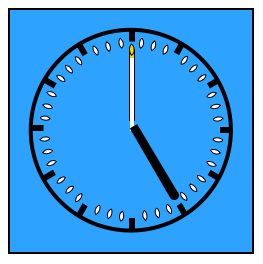 ... And this clockface shows the start of the day (2 o'clock in the morning by our reckoning)
... And this clockface shows the start of the day (2 o'clock in the morning by our reckoning)
Both hands move anti-clockwise. The black hand sweeps out one revolution every 24 hours and the colour hand every 2 hours.
The black and coloured hands do not move continuously but in steps. The black hand moves 3.75 degrees every 15 minutes, and the secondary arm moves 7.5 degrees every 2.5 minutes.
When the colour hand over takes the black hand it stops 3.75 minutes at one side of the main hand, and then moves directly (2 steps) to the other side of the main hand and stops there for 3.75 minutes. After that it does a step and waits 2.5 minutes, etc. etc. ... until it encounters the black hand again.
The clocktower is surmounted by a green conic roof (actually not really conic ... the roof slope decreases as you get nearer the bottom). Lighting from under the roof could be provided for each face. Either that or the faces could be illuminated from within at night. The faces are not exactly vertical but the top slightly overhangs the bottom.
There is never any numbering on the face.
The clock also emits sounds. Every 2 of our hours the clock makes a deep "boing" which reverberates for some time. Also from 6 in the morning to 6 at night, the clock emits a "boing" every 30 of our minutes. The first "boing" has no accompaniment. However the second "boing" is followed (well actually when the "boing" is only .67 % dissipated) by a "sharper" sound that dies down a lot quicker. Lets call this the "teen" sound. The third "boing" has 2 "teen"s 0.72 seconds apart. The fourth has 3 "teen"s. The fifth one is back to the single "boing" and so it continues through-out the daylight hours.
Below is more detail about the hands and the markings on the clock face. Notice that the colour hand can come in two varieties. The "diamond" variety and the "eye-shape variety. Of course you only get one variety on any one clock.
... Some Musings
..
beugan should arrange the beumi in such a way that people of "compassion" and "taste" always rise to the top of the organisation and and also by having a method that allows for continuous revision of every aspect of itself, béu should produce truths and ways that are very worthy of regard.
"béu" specifies certain "best practices" for many many aspects of life. These "best practices" encompass many varied aspects of life.
For example the manner in which the 5 yearly festivals should be celebrated, what screw shapes and sizes should be used, how a man should treat his wife and a woman her husband, the periods of fasting and dietary restrictions that each individual should undertake.
These are just some examples of these "best practices". Actually each of these "best practices" are given a level of importance. There are 3 of these levels ... "recommended", "highly recommended" and "an absolute must".
These "best practices" are set out in various books. Theses books are held to be "canonical" or holy. However these writings are not set in stone, and there are mechanisms where by these books are updated and also new books can be added to the "special books".
Some people consider these "special books" to constitute a religion that has no god. However other people follow these "best practices" as just "cool things to do" and fit them in to their lives under another over-reaching belief system, such as Christianity or Islam (in much the same way that the early Buddhist adherent were free either to forget the old hindu gods or to continue to venerate them).
béu place great importance upon education and lifelong learning. There is a core body of work that all béumai must read. Also there are a great many “recommended works” that they are encouraged to study.
The most important “daily ritual” is 15 minutes given over to the study of these books..
béumai are expected to show generosity, hospitality, and to constantly pursue of social justice and reform of poor institutions. They are discouraged from the excessive pursuit of luxury and status.
Rather … they believe that in order to be happy, you need …
1) A community of good friends
2) To be engaged in work that gives satisfaction (as part of this self-empoyment is look favourably on)
3) To spend a part of each day in contemplation (reading the holy books is believed engenders this contemplation) ... beumai believe that the highest calling in life is to expand the body of knowledge that humanity possesses ( peugəŋgau) ... to accomplish addition or amendment to one of the treasure of books that are considered "cannonical" is to gain the greatest regard possible from fellow beumai.
For the harmonious functioning of society as a whole, everybody should follow the rule …
1) What you do not wish for yourself, do not do to others
beumi tend to be quite focused on their occupation. In fact, to a large extent, they consider that there position in society is defined by their professional lives. This focus produces a motivated and consciencious labour force. beimi believe that "if a job is worth doing* it is worth doing right". They take immense satisfation in completing a task to the highest standards.
Also there is a mania for "optimization", to find the exact most efficient way to do a certain task. Stemming from this ... many people are interested in calculous.
*But who decides what job to do, what job is worth doing ?
Probably the most detailed part of béu is beuba (the language of béu).
First some new words concerning béu ...
beuki = a person that follows béu and takes part in the community of béu
beumai = a person that follows béu but follows in a private manner.*
beumi = all the people that follow béu
beugan = béumi plus all the paraphernalia of béu (i.e. buildings, flags, clothes, etc. etc.)
Note ... I will not use the term beuba from now on ... I shall simply say béu. This is sufficient since it is obvious that I am talking about the language. In a similar way, in a book about language you do not continuously come across the term "the English language" ... but rather "English".
The foundations of béu
Some questions and answers ...
Question ... What is béu ?
Answer ... béu is a way of life.
Question ... Where does béu come from ?
Answer ... Well béu was wilfully constructed here, down on earth, by humans. But actually béu is designed to evolve over time, so maybe it is better to say that béu is "being constructed", rather than "was constructed".
Question ... Why was béu constructed ?
Answer ... béu was constructed to fill a gap in the life of a man. Or perhaps it would be better to say ... béu was constructed to fill a gap in the lives of men.
Question ... What was the starting point in this construction ?
Answer ... The starting point for constructing béu was to ask two questions. Which were ....
What is a human being ?
What is the point of life ?
After some thought the first question was answered on three different levels …
A) ... A collection of genes.
B) ... A collection of urges ... to eat, to drink, to have sex, etc etc etc
C) ... A network of friends and family … loved-ones.
And after some further thought the answer to the second question was answered …
D) … To get enough food.*
* WHAT ??? ... To get enough food ... is that it ??
it is not a complete answer ... but it is about 80% or 90% of the answer)
E) ... Other bits and pieces ... but really, they pale into insignificance compared to D).
beugan attemps to set up a network of beumi. This network is in no way meant to supplant (C) ... rather to extend and enhance (C).
Interaction with other people re-inforces our feeling of being a complete person. In fact with out contact with other poplethe soul fades, days merge into meaningless days, there is no purpose to anything. Now any human contact at all guards against this fading of the soul. However to get a positive affect, to get a flourishing of the soul, it is necessary to have contact with people that have your best interests at heart.
béu is an attempt to build a "framework" for life. A framework that is compatible with the 4 answers given above. But why a framework, you might ask. Well it seems to be a psychological need. Because people are happier when they are told what they can and can not do, what goals are worth striving for and which are worthless. And also as part of this "framework" ... well people like "ritual", they like purposeful action without too much thought, they like the thought that they are part of something bigger than themselves, they like to feel meaning in their lives, they like to feel that they are part of a tradition that stretches back eons and eons. ( OK ... béu can not fulfil the last item ... or at least, not at the moment)
In short béu is a gigantic collection of meme's ... aesthetically pleasing and slotting together harmoniously with each other.
..
Three basic concepts ... angwa, honda and aska
At the centre of this body of work defining the "best practices" there are 3 important concepts.
angwa can best be translated as "harmony"
When used in relation to motion it can be translated as "grace" When used in relation to design it can be translated as "elegance" When used in relation to text it can be translated as "poetry"
angwai is an adjective meaning "graceful", "elegant" or "poetic"
angwa is considered getting the right balance between honda and aska
honda can best be translated as "order"
aska can best be translated as "chaos"
..
... End Notes
..
[THIS SHOULD BE MOVED TO THE END OF CHAPTER 10, AT SOME TIME IN THE FUTURE]
..
The most basic choice that I had to make was nominative-accusative or ergative-absolutive.
..
..
This choice was actually made on phonological grounds.
OK the following had been decided already ...
1) The unmarked noun form should be the most common.
2) Case should be implemented by suffixes.
3) The marking that was given should be as light as possible.
4) the only word final consonants allowed were n and s
The decision made on phonological grounds was, there is a certain stridency to the s sound, to my mind matching up well with "source of action".
lead me to the following choices ...
..
The second option was chosen was made because n already had been assigned a heavy grammatical load.
So ... there we had it .... ergative-absolutive and an s-suffix adorning the A-argument.
..
Having a split system was also considered ... pronoun O-arguments being adorned with an n-suffix and non-pronoun A-arguments being adorned with an s-suffix.
This system was rejected for the same reason ... we already had too many "n"s turning up (I was thinking about simplicity as well, when I rejected the split system)
Index
- Introduction to Béu
- Béu : Chapter 1 : The Sounds
- Béu : Chapter 2 : The Noun
- Béu : Chapter 3 : The Verb
- Béu : Chapter 4 : Adjective
- Béu : Chapter 5 : Questions
- Béu : Chapter 6 : Derivations
- Béu : Chapter 7 : Way of Life 1
- Béu : Chapter 8 : Way of life 2
- Béu : Chapter 9 : Word Building
- Béu : Chapter 10 : Gerund Phrase
- Béu : Discarded Stuff
- A statistical explanation for the counter-factual/past-tense conflation in conditional sentences





























